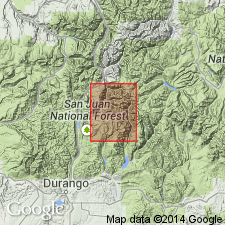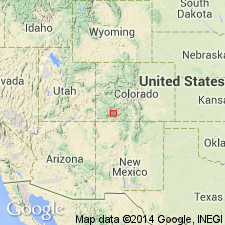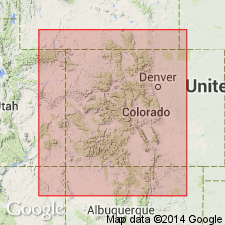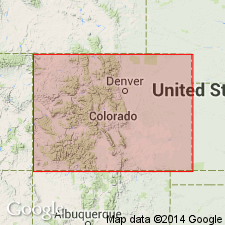
- Usage in publication:
-
- Trimble granite*
- Modifications:
-
- Original reference
- Dominant lithology:
-
- Granite
- AAPG geologic province:
-
- Southern Rocky Mountain region
Summary:
Trimble granite. Fine-grained gray biotite granite. Intrudes Eolus granite in neighborhood of Trimble Pass, La Plata County, southwestern Colorado, but does not intrude Ignacio quartzite [Upper Cambrian]. [Mapped over large area surrounding Trimble Pass.]
[GNC remark (ca. 1936, US geologic names lexicon, USGS Bull. 896, p. 2183): For 1935 Colorado geol. map this formation was included in Front Range granite group and assigned to pre-Cambrian.]
Source: US geologic names lexicon (USGS Bull. 896, p. 2183).

- Usage in publication:
-
- Trimble Granite*
- Modifications:
-
- Overview
- Geochronologic dating
- AAPG geologic province:
-
- Southern Rocky Mountain region
Summary:
Underlies about 5 sq mi of Vallecito basin, East Silver Mesa, Missouri Gulch, and the area from Florida Mountain, Needle Mountains, La Plata Co, CO in the Southern Rocky Mountain region. Contacts are well defined except where dikes of Trimble extend outward into the Eolus. Shown as the youngest Precambrian unit on the geologic sketch map. Consists of pale-pink to light-brick-red, massive, homogeneous, fine- to medium-grained granite. Is commonly porphyritic; contains 1-5 percent blocky to tabular 1/8 to 1 in long microcline phenocrysts. Calcic oligoclase to sodic andesine form 10 to 15 percent of the rock. Biotite present as thick tablets. Has a Rb-Sr whole rock age of 1,350 +/-50 m.y.
Source: GNU records (USGS DDS-6; Denver GNULEX).

- Usage in publication:
-
- Trimble Granite*
- Modifications:
-
- Overview
- AAPG geologic province:
-
- Southern Rocky Mountain region
Summary:
Occurs in a moderately large stock intruded into Eolus Granite in Needle Mountains. Listed with granitic rocks and gabbro of circa 1,400 m.y. (Precambrian Y) age group.
Source: GNU records (USGS DDS-6; Denver GNULEX).

- Usage in publication:
-
- Trimble Granite*
- Modifications:
-
- Overview
- AAPG geologic province:
-
- Southern Rocky Mountain region
Summary:
Is one of ten formally named lithodemic units assigned to the Middle Proterozoic Berthoud Plutonic Suite (a new name) in the Southern Rocky Mountain region. Recognized in one stock about 13 km sq (5 mi sq) in the center of the Eolus batholith in Needle Mountains. Is a pink to light-red, fine- to medium-grained, equigranular granite with small amounts of muscovite. Is considerably younger than the Eolus Granite.
Source: GNU records (USGS DDS-6; Denver GNULEX).
For more information, please contact Nancy Stamm, Geologic Names Committee Secretary.
Asterisk (*) indicates published by U.S. Geological Survey authors.
"No current usage" (†) implies that a name has been abandoned or has fallen into disuse. Former usage and, if known, replacement name given in parentheses ( ).
Slash (/) indicates name conflicts with nomenclatural guidelines (CSN, 1933; ACSN, 1961, 1970; NACSN, 1983, 2005, 2021). May be explained within brackets ([ ]).

